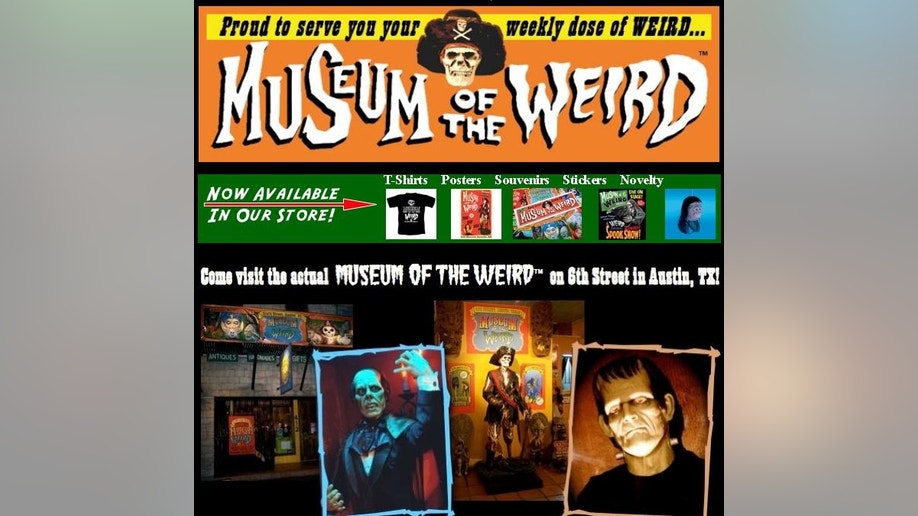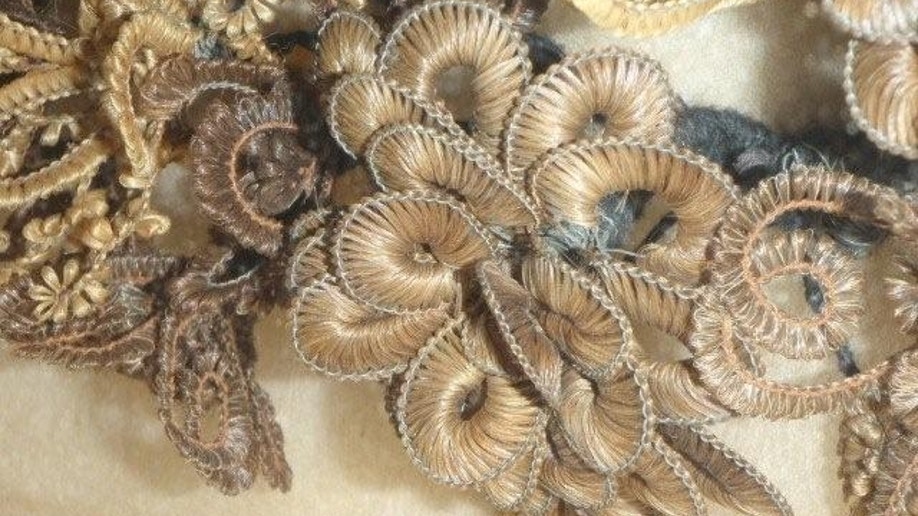18 Weirdest Museums on Earth
{{#rendered}} {{/rendered}}
<b>Where:</b> Austin, TX <b>What:</b> The Museum of Weird houses all the oddities you'd ever want to see. The collection includes movie monsters, shrunken heads, the Fiji Mermaid, giant lizards and...the supernatural. <b>Website: </b><a href="http://www.museumoftheweird.com/">www.museumoftheweird.com</a> (The Museum of Weird)

<b>Where:</b> Independence, Missouri <b>What:</b> Featuring 159 wreaths and over 2,000 pieces of jewelry made of human hair, Leila's Hair Museum celebrates the 18th and 19th Century tradition of making keepsakes out of the hair of loved ones. Leila's Hair Museum recently became the national headquarters for the Victorian Hairwork Society. <b>Web Site:</b> <a href="http://www.hairwork.com/leila/">www.hairwork.com</a> (Leila Cohoon)
<b>Where:</b> Auburn, WA <b>What: </b>The Washington Banana Museum houses over 4,000 banana-related artifacts, including vintage advertisements and folk art. Curator Ann Mitchell Lovell began collecting banana-inspired oddities after a 1980 trip to Hawaii and since then, "the collection just came in a bunch!" <b>Web Site:</b> <a href="http://www.bananamuseum.com/">www.bananamuseum.com</a> (The Washington Banana Museum)
<b>Where: </b>Seattle, WA <b>What: </b>The Giant Shoe Museum exhibits, you guessed it, giant shoes. A shoe worn by Robert Wadlow, the world's tallest man, is on display, as is a five-foot-long wing tip shoe from the 1920s. <b>Web Site:</b> <a href="www.roadsideamerica.com/tip/1406">www.roadsideamerica.com/tip/1406</a> (The Giant Shoe Museum)
<b>Where:</b> New York, NY <b>What: </b>The New York Museum of Water focuses on educating people about responsible water use. Exhibits include water-inspired artwork and water education workshops. <b>Web Site:</b> <a href="http://nymw.org/wholesiteJune2006/more_about_us.htm">www.nymw.org</a> (The New York Museum of Water)
<b>Where:</b> Keswick, Cumbria, United Kingdom <b>What:</b> Located on the grounds of an old pencil factory, the Cumberland Pencil Co. Museum displays a variety of artifacts relevant to the production of colored pencils, from raw materials to machinery to packaging. Though the factory was built in 1832, the manufacture of colored pencils in the region stretches back 350 years. The museum was founded 25 years ago and welcomes 80,000 visitors per year. <b>Web Site:</b> <a href="http://www.pencilmuseum.co.uk/">www.pencilmuseum.co.uk</a> (The Cumberland Pencil Co. Museum)
<b>Where: </b>El Dorado Hills, CA <b>What: </b>Housed in back of a barber shop, Barber Jon's collection of aboriginal shrunken heads, an authentic jackalope and the remains of a Fiji Mermaid are truly strange. The best part: Admission is free with a haircut. <b>Web Site: </b><a target="_blank" href="http://www.barberjons.com/museum.htm">www.barberjons.com/museum.htm</a> (Barber Jon's Curiosity Museum)
<b>Where: </b>Yokohama, Japan <b>What: </b>The quintessential college food staple has its own museum in Japan, for true fans and connoisseurs of the ramen noodle. It features manufacturing equipment, ramen bowls, chopsticks and wrappers, matchbooks from ramen shops, and more. <b>Web Site: </b><a href="http://www.raumen.co.jp/home/index.html">www.raumen.co.jp</a> (Shin-Yokohama Raumen Museum)
<b>Where: </b>Middleton, WI <b>What: </b>Everyone's favorite condiment has a remarkably thorough museum. More than just a gift shop, the gallery features an extensive collection of prepared mustards -- more than 5,000 jars, bottles, and tubes from all 50 states and more than 60 countries. The Museum also is home to hundreds of mustard-related items of great historical importance, including mustard pots and vintage mustard advertisements. <b>Web Site:</b> <a href="http://www.mustardweb.com">www.mustardweb.com</a> (The National Mustard Museum)
<b>Where: </b>Ves’kovo village, Pereslavl, Russia <b>What: </b>An old merchant’s house not far from the town’s center houses one of the strangest museums you'll ever visit. Its collection includes some 200 irons made in Russia, Germany and Poland between the 17th and 20th centuries. A guided tour is sure to inform, with details on the principles of operation and weight. <b>Web Site: </b><a href="http://pereslavl-zalessky.com/ytuga_en.htm">pereslavl-zalessky.com/ytuga_en.htm</a> (Pereslavl-Zalessky.com)
<b>Where: </b>Ves’kovo village, Pereslavl, Russia <b>What: </b>A log house in the same town as the museum of irons holds an equally strange collection: kettles. The museum has more than 100 exhibits on the subject, and includes various copper, porcelain, and German silver kettles of different types and shapes. The museum's Web site explains that visitors can also see household utensils used in Russia in the 19th and early 20th centuries. <b>Web Site: </b><a href="http://pereslavl-zalessky.com/chainika_en.htm">pereslavl-zalessky.com/chainika_en.htm</a> (Pereslavl-Zalessky.com)
<b>Where:</b> New Delhi, India <b>What:</b> Inspired by the evolution of toilets over time, Dr. Bindeshwar Pathak founded the museum to educate the public about past sanitation practices to enable innovations in the field. Pathak created the sanitation-focused, non-governmental organization Sulabh International Social Service Organization and is a consultant for the U.N.'s Economic and Social Council. The museum's collection includes toilets from around the world, spanning the colorful history of sanitation. <b>Web site:</b><a href="http://www.sulabhtoiletmuseum.org/pg01.htm">www.sulabhtoilet.org</a> (www.sulabhtoiletmuseum.org)
<b>Where: </b>The R - Lucky Star Ranch, Marsing, Idaho <b>What: </b>If you like farm equipment, you'll love a visit to the Lucky Star Ranch, which bills itself as home of the largest, organized, farm implement wrench collection in the world. The collection is housed in a former tractor shed, where museum operaters also have the world's largest sugar sack collection -- which is pretty odd in itself. <b>Web Site: </b><a href="http://www.rluckystarranch.com/">www.rluckystarranch.com</a> (R-Lucky Star Ranch)
<b>Where: </b>St. Paul, Minnesota <b>What: </b>The collection of the Museum of Questionable Medical Devices was moved to the Science Museum of Minnesota in 2002, but the artifacts Founder Bob McCoy gathered up remain wonderfully available there. The museum gathers up Kellogg's early vibrating chair, the psychograph (which helped the pseudo-science of phrenology), and more. <b>Web Site:</b> <a href="http://www.museumofquackery.com/welcome.htm">www.museumofquackery.com</a> (Santa Monica Press)
<b>Where: </b>Houston, Texas <b>What: </b>Open since 1992, the National Museum of Funeral History aims to "preserve the rich heritage of the funeral industry" -- and does so in grand style, with over 35,500 square feet of exhibition space. It features exhibits on the lives and deaths of popes, Civil War-era embalming, fantasy coffins, like those shown here, and more. <b>Web Site: </b>National Museum of Funeral History: <a href="http://www.nmfh.org/">www.nmfh.org</a> (The National Museum of Funeral History)
<b>Where: </b>Needham, Massachusetts <b>What: </b>Featuring art that's unfit for many a museum wall, the Museum of Bad Art, or MOBA, began with a single painting being pulled from the trash. "Lucy in the Field with Flowers" was the seed from which MOBA sprung. The museum now maintains a collection of 400 pieces, which are "too bad to be ignored." <b>Web Site: </b><a href="http://www.museumofbadart.org/index.php">www.museumofbadart.org</a> (Courtesy of the Museum Of Bad Art)
<b>Where: </b>Philadelphia, Pennsylvania <b>What: </b>Before the "Bodies" exhibit, there was the Mütter Museum. Created in 1859 as an educational tool for College of Physicians of Philadelphia students, the collection is composed of 20,000 specimens of medical anomalies, like a cast of Siamese Twins Chang and Eng and Joseph Hyrtl's collection of skulls. <b>Web Site: </b><a href="http://www.collphyphil.org/MUTTER.ASP">www.collegeofphysicians.org</a> (George Widman courtesy of the Mütter Museum of The College of Physicians of Philadelphia)
